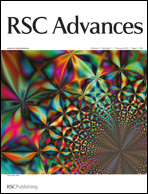Microwave-assisted coating of carbon nanostructures with titanium dioxide for the catalytic dehydration of d-xylose into furfural†
Abstract
Titanium dioxide was selectively grown on reduced graphene oxide (TiO2/RGO) and carbon black (TiO2/CB) by a microwave-assisted synthesis in


 Please wait while we load your content...
Please wait while we load your content...